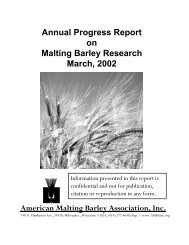Annual Progress Report on Malting Barley Research March, 2007
Annual Progress Report on Malting Barley Research March, 2007
Annual Progress Report on Malting Barley Research March, 2007
You also want an ePaper? Increase the reach of your titles
YUMPU automatically turns print PDFs into web optimized ePapers that Google loves.
CI9214, PI552963 (Heartland), and NDB112. All other resistance sources were<br />
susceptible to at least <strong>on</strong>e isolate collected in 2005.<br />
What were the most significant accomplishments?<br />
The most significant accomplishment in this work was the identificati<strong>on</strong> of which<br />
resistant sources are overcome and which <strong>on</strong>es c<strong>on</strong>tain potentially durable net<br />
blotch resistance that could be used in combating net blotch in this regi<strong>on</strong> as well as<br />
the identificati<strong>on</strong> of virulence changes within the pathogen populati<strong>on</strong> from year to<br />
year.<br />
Objective:<br />
Net blotch caused by the fungus Pyrenophora teres Drechs. f. teres Smedeg.<br />
(anamorph: Drechslera teres) is <strong>on</strong>e of the most ec<strong>on</strong>omically important diseases in<br />
barley growing regi<strong>on</strong>s of the United States and the world. This disease is a<br />
perennial problem especially in cool, wet barley growing regi<strong>on</strong>s although it has<br />
been seen in dry regi<strong>on</strong>s as well (Mathre 1982). The majority of barley cultivars<br />
grown in the United States are moderately to highly susceptible to net blotch of<br />
barley. Therefore, it is critical that we have an understanding of the pathogen<br />
populati<strong>on</strong> to properly develop barley cultivars with durable resistance to net blotch.<br />
The objective of this project was to evaluate the North Dakota field populati<strong>on</strong> at two<br />
locati<strong>on</strong> with two significantly different envir<strong>on</strong>ments. This study focused <strong>on</strong> the<br />
level of variability present in the P. teres populati<strong>on</strong> as it relates to identified host<br />
resistance in a differential barley set.<br />
Methodologies:<br />
Host differential set<br />
A host differential set of 20 barley lines (Table 1) was chosen based <strong>on</strong><br />
published differential reacti<strong>on</strong> of these lines. (Jalli 2004, Wu et al. 2003, Cromey<br />
and Parks 2003, Gupta and Loughman 2001, J<strong>on</strong>ss<strong>on</strong> et al. 1997, Steffens<strong>on</strong> and<br />
Webster 1992, Tekauz 1990, Kahn 1982, Kahn and Boyd 1969). This was d<strong>on</strong>e by<br />
evaluating the most thorough publicati<strong>on</strong>s <strong>on</strong> differential sets. All lines used in this<br />
differential set have been shown to have different resistance patterns when<br />
inoculated with isolates from around the world indicating that each line harbors at<br />
least <strong>on</strong>e different resistance gene. NDB112 and Heartland (Table 1) have also<br />
been added to this set based <strong>on</strong> their use as resistance sources in the North Dakota<br />
and Minnesota barley breeding program, respectively.<br />
Field collecti<strong>on</strong> and pathotype analysis <strong>on</strong> the barley differential set<br />
Field plots of the near universal susceptible cultivar Hector were planted <strong>on</strong><br />
barley stubble to ensure the best disease possible. Hector plots were established<br />
at Fargo and Langd<strong>on</strong>, ND in both 2004 and 2005. Diseased leaves were collected<br />
throughout the growing seas<strong>on</strong>. Leaves were plated <strong>on</strong> sterile water agar and<br />
single spore isolates were picked from net blotch lesi<strong>on</strong>s. Isolates were grown and<br />
93
















